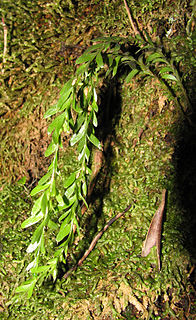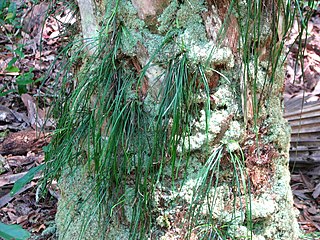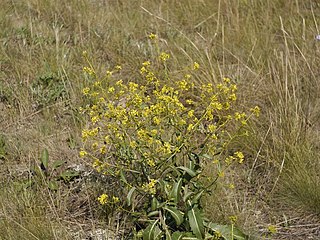
A fern is a member of a group of vascular plants that reproduce via spores and have neither seeds nor flowers. The polypodiophytes include all living pteridophytes except the lycopods, and differ from mosses and other bryophytes by being vascular, i.e., having specialized tissues that conduct water and nutrients and in having life cycles in which the branched sporophyte is the dominant phase. Ferns have complex leaves called megaphylls, that are more complex than the microphylls of clubmosses. Most ferns are leptosporangiate ferns. They produce coiled fiddleheads that uncoil and expand into fronds. The group includes about 10,560 known extant species. Ferns are defined here in the broad sense, being all of the Polypodiopsida, comprising both the leptosporangiate (Polypodiidae) and eusporangiate ferns, the latter group including horsetails, whisk ferns, marattioid ferns, and ophioglossoid ferns.

The Fern Rock Transportation Center is a SEPTA rail and bus station located at 10th Street and Nedro Avenue in the Fern Rock neighborhood of Philadelphia, Pennsylvania. Fern Rock serves as the northern terminus and yard for SEPTA's Broad Street Line, as well as a stop for SEPTA Regional Rail's Lansdale/Doylestown Line, Warminster Line, and West Trenton Line.

The elongated tortoise is a species of tortoise found in Southeast Asia and parts of the Indian Subcontinent, particularly Nepal.
NVC community W2 is one of the woodland communities in the British National Vegetation Classification system. It is one of seven woodland communities in the NVC classed as "wet woodlands".

Ulmus elongata, also known as the long raceme elm in the US, is a deciduous tree endemic to broadleaf forests in the eastern provinces of China.
Alsophila engelii, synonym Cyathea elongata, is a species of tree fern native to Venezuela and Colombia, where it grows in montane areas at an altitude of 2000–3000 m. The trunk is erect and up to 11 m tall. Fronds are pinnate and usually 2–3 m long. The rachis and stipe are brown, may be smooth to warty and have basal tan scales. Sori occur in small groups towards the base of the pinnule midvein and are covered by cup-like indusia.

The snaggletooth shark, or fossil shark, is a species of weasel shark in the family Hemigaleidae, and the only extant member of the genus Hemipristis. It is found in the Indo-West Pacific, including the Red Sea, from southeast Africa to the Philippines, north to China, and south to Australia, at depths from 1 to 130 metres. This shark can be found near the bottom of the water column of coastal areas, but can be found at continental and insular shelves. Its length is up to 240 cm (7.87 ft). Despite being only vulnerable to extinction, this shark is very rarely seen.

The elongated shrew is a species of mammal in the family Soricidae. It is endemic to the island of Sulawesi in Indonesia. It lives in the forests of central, northern, and eastern Sulawesi from 200 to 2000 meters elevation.

Tmesipteris, the hanging fork ferns, is a genus of ferns, one of two genera in the family Psilotaceae, order Psilotales . Tmesipteris is restricted to certain lands in the Southern Pacific, notably Australia, New Zealand and New Caledonia. In New Zealand this hanging epiphyte is common in the warm temperate rain forests of both main islands, where it can normally be found as short spiky dark-green fronds, often with lighter bag-like sporangia at the bases of some of its "leaves". The plant possesses no true leaves; what appear to be leaves are flattened stems. The fronds emerge directly from the fibrous root-mats which clad the trunks of mature tree ferns such as Dicksonia and Cyathea. Tmesipteris is from the Greek language, meaning a "cut fern", referring to the truncated leaf tips.

Sorindeia is a genus of some three dozen plant species that are native to tropical Africa, Madagascar, the Comoro Islands and Mascarene Islands. They are distinguished by their compound leaves, large inflorescences and distinctive fruit. In the case of S. madagascariensis, as many as 200 fruit may be carried on a pendant cluster.

Vittaria, the shoestring ferns, is a genus of ferns in the Vittarioideae subfamily of the family Pteridaceae. It had previously been placed in the family Vittariaceae, but that family is no longer recognized.

Woodsia is a genus of ferns in the order Polypodiales. In the Pteridophyte Phylogeny Group classification of 2016 (PPG I), it is the only genus in the family Woodsiaceae, placed in the suborder Aspleniineae. The family can also be treated as the subfamily Woodsioideae of a very broadly defined family Aspleniaceae sensu lato. Species of Woodsia are commonly known as cliff ferns.

Himanthalia elongata is a brown alga in the order Fucales, also known by the common names thongweed, sea thong and sea spaghetti. It is found in the north east Atlantic Ocean and the North Sea.

Angiopteris evecta, commonly known as the king fern, giant fern, elephant fern, oriental vessel fern, Madagascar tree fern, or mule's Foot fern, is a very large rainforest fern in the family Marattiaceae native to most parts of Southeast Asia and Oceania. It has a history dating back about 300 million years, and is believed to have the longest fronds of any fern in the world.

Metaxya is a neotropical genus of ferns in the order Cyatheales. It is the only genus in the family Metaxyaceae in the Pteridophyte Phylogeny Group classification of 2016. Alternatively, the genus may be placed in the subfamily Metaxyoideae of a more broadly defined family Cyatheaceae, the family placement used in Plants of the World Online as of November 2019.

Brassica elongata, the elongated mustard or long-stalked rape, is a species of the mustard plant that is native to parts of Central Europe, Eastern Europe, the Balkan Peninsula, the Caucasus, Morocco and parts of Central Asia. Through plant invasion this species has become naturalized in many other parts of the world. Some of these naturalized regions include South Africa, North Western Europe, Australia and North America. Given the wide range of climate and ecological conditions of these regions, B. elongata has been able to disrupt the ecosystems of their native plant habitats and has been label as an invasive species in many of its naturalized zones. In North America, this species is often found as a roadside weed in the southwestern states, particularly in the state of Nevada. Studies allude that the Cruciferae might have migrated through the Bering land bridge from what is now Central Asia. Commonly known as the long-stalked rape or as langtraubiger Kohl in German, this species is a close cousin to Brassica napus (rapeseed) and a secondary genetic relative to B. oleracea (kale). As a close genetic species of the rapeseed, the long-stalked rape has one of the highest counts of accumulated polyunsaturated linoleic and linolenic acid. Both compounds are heavily used to manufacture vegetable oils. Brassica elongata has the propagative potential of turning into a horticultural product from what is currently a noxious weed.
C. elongata may refer to:

Pityrogramma, the silverback ferns, or goldback ferns, is a fern genus in the subfamily Pteridoideae of the family Pteridaceae.

Tmesipteris elongata is a fern ally endemic to south eastern Australia and New Zealand. Often seen growing on soft tree ferns in moist valleys.
Tmesipteris horomaka, commonly known as the Banks Peninsula fork fern, is a fern ally endemic to New Zealand.















